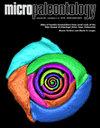Biostratigraphy of larger foraminifera from the Middle Eocene Jahrum-Pabdeh formations (Zagros region, SW Iran) and their correlation with the planktonic foraminiferal zones
IF 1.6
4区 地球科学
Q3 PALEONTOLOGY
引用次数: 1
Abstract
Eocene larger benthic foraminifera including orthophragmines, nummulitids and alveolinids from the Jahrum and Pabdeh formations in the Zagros region are presented. The studied 20-m-thick stratigraphic interval contains, Asterocyclina Gumbel 1870, Nemkovella Less 1987, Orbitoclypeus Silvestri 1907, Discocyclina Gumbel 1870, Nummulites Lamarck 1801, Assilina d'Orbigny 1826 and Alveolina d'Orbigny 1826. This larger benthic foraminiferal assemblage testifies for the shallow benthic zones (SBZs) 15 to 17, which ranges from the middle Lutetian up to the early Bartonian. Further micropaleontological analysis made on intercalated planktonic-rich levels helps calibrate the larger foraminifera biostratigraphy, demonstrating a correlation with the E11 biozone. This confirms that the chronostratigraphic calibration of the SBZs made by previous authors for the peri-Mediterranean area can, through the middle Lutetian to the early Bartonian, be applicable in the Middle East as well.伊朗西南部Zagros地区中始新世Jahrum-Pabdeh组大型有孔虫生物地层学及其与浮游有孔虫带的对比
本文介绍了Zagros地区Jahrum和Pabdeh组始新世大型底栖有孔虫,包括orthophragmines, nummultiids和alveolinids。所研究的20 m厚地层层段包括Asterocyclina Gumbel 1870、Nemkovella Less 1987、Orbitoclypeus Silvestri 1907、Discocyclina Gumbel 1870、Nummulites Lamarck 1801、Assilina d’orbigny 1826和Alveolina d’orbigny 1826。这个较大的底栖有孔虫组合证明了浅底栖带(SBZs) 15至17,范围从中期鲁特世到早期巴尔顿世。在富含浮游生物的插层水平上进行的进一步微体古生物学分析有助于校准较大的有孔虫生物地层,证明了与E11生物带的相关性。这证实了前人对地中海沿岸地区从中鲁特世到早期巴尔顿世的sbz年代学定标同样适用于中东地区。
本文章由计算机程序翻译,如有差异,请以英文原文为准。
求助全文
约1分钟内获得全文
求助全文
来源期刊

Micropaleontology
地学-古生物学
CiteScore
3.20
自引率
6.70%
发文量
18
审稿时长
>12 weeks
期刊介绍:
The Journal of Micropalaeontology (JM) is an established international journal covering all aspects of microfossils and their application to both applied studies and basic research. In particular we welcome submissions relating to microfossils and their application to palaeoceanography, palaeoclimatology, palaeobiology, evolution, taxonomy, environmental change and molecular phylogeny. Owned by The Micropalaeontological Society, the scope of the journal is broad, demonstrating the application of microfossils to solving broad geoscience issues.
 求助内容:
求助内容: 应助结果提醒方式:
应助结果提醒方式:


